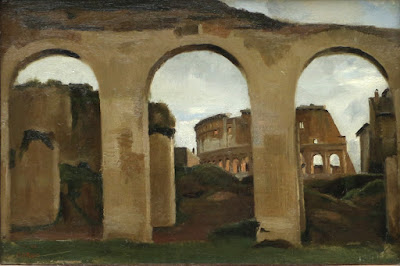 |
| Jean-Baptiste-Camille Corot Interrupted Reading ca. 1870 oil on canvas Art Institute of Chicago |
 |
| Jean-Baptiste-Camille Corot The Student ca. 1854 oil on canvas Musée du Louvre |
 |
| Jean-Baptiste-Camille Corot Woman with a Pearl ca. 1868-70 oil on canvas Musée du Louvre |
 |
| Jean-Baptiste-Camille Corot Velléda ca. 1868-70 oil on panel Musée du Louvre |
 |
| Jean-Baptiste-Camille Corot Portrait of Alexina Legoux ca. 1835 oil on canvas Musée du Louvre |
 |
| Jean-Baptiste-Camille Corot Italian Woman ca. 1825-28 oil on paper, mounted on canvas Musée du Louvre |
 |
| Jean-Baptiste-Camille Corot Reading Monk ca. 1840 oil on canvas Musée du Louvre |
 |
| Jean-Baptiste-Camille Corot View of the Roman Colosseum from the Arcade of the Basilica of Constantine 1825 oil on paper, mounted on canvas Musée du Louvre |
 |
| Jean-Baptiste-Camille Corot View of Genoa 1834 oil on canvas Art Institute of Chicago |
 |
| Jean-Baptiste-Camille Corot View of Florence from the Boboli Gardens ca. 1835-40 oil on canvas Musée du Louvre |
 |
| Jean-Baptiste-Camille Corot Volterra - The Citadel 1834 oil on canvas Musée du Louvre |
 |
| Jean-Baptiste-Camille Corot Ischia - View from the Slopes of Mount Epomeo 1828 oil on paper, mounted on canvas Musée du Louvre |
 |
| Jean-Baptiste-Camille Corot La Cervara - Roman Campagna 1830-31 oil on canvas Cleveland Museum of Art, Ohio |
 |
| Jean-Baptiste-Camille Corot Bridge of Narni near Rome 1826 oil on paper, mounted on canvas Musée du Louvre |
 |
| Jean-Baptiste-Camille Corot Ponte Numentano - Roman Campagna ca. 1825-28 oil on paper, mounted on canvas Museum Boijmans Van Beuningen, Rotterdam |
Jean-Baptiste-Camille Corot (1796-1875) – French painter, much admired for his landscape paintings but at heart a classicist. His early work comprised mainly history subjects set in landscapes in the tradition of Poussin. The works called 'studies' show remarkable powers of observation and organization, especially those done in Italy during 1825-8: they are mainly landscapes but also pictures of women in their regional costumes, dignified and calm. He continued to produce history paintings for exhibition in the Salon but in 1838, after a second visit to Italy and travels in France, he also sent fully developed landscape paintings. In 1843 he made a third trip to Italy. Modest, generous, and sociable, Corot had many friends. His character may have helped him gain the Légion d'Honneur in 1846 and to win the sympathy of the art critics Baudelaire and Champfleury. Benefitting from the change of cultural tone occasioned by the 1848 revolution, he sent a landscape study of 1826 to the 1849 Salon as well as a religious painting. Pissarro and Monet admired his exhibited work and his growing popularity helped to draw attention to naturalism. He became a prominent member of the Salon jury and during the Franco-Prussian War donated a large sum for the defence of France. He left Paris when the Commune took power and spent his remaining years wandering about France.
– excerpted from the Yale Dictionary of Art and Artists (2000) by Erika Langmuir and Norbert Lynton